Rudy Rucker's Blog, page 35
September 1, 2013
Timeline for My Transreal Novels
As I often say, I’ve written many of my SF novels in what I call a “transreal” style. This means that, although the novels deal with science-fictional scenes, the characters and situations in the novels are to some extent modeled on me, the people around me, and events I’ve experienced in my life. I had this idea back in 1983, very early in my career. You can find “A Transrealist Manifesto” as part of my Collected Essays, which I recently put online.
I’ve always thought that, in a loose sense, my transreal novels could be thought of as parts of a single extended work, and back in 1990, I made up a table for six of the novels, trying to show how the books might fit together. (You can find that table in the very first answer in my compilation All the Interviews, which is, as of today, 382 Q & A pairs long.)
This week, my friend Paul Di Filippo happened to send me a link to an article about Jack Kerouac’s thirteen-novel cycle, the Duluoz Legend.
So I spent August 30, 2013, making up an extensive…
Timeline for Rucker’s Transreal Novels
Book Title
R’s “Name”
R Life
R Activities
Frek and the Elixir
Frek Huggins
1956-59
Boyhood in Louisville
The Secret of Life
Conrad Bunger
1963-67
College, engagement
Spacetime Donuts
Vernor Maxwell
1968
Being a hippie
Master of Space and Time
Joe Fletcher
1969
Newlywed, grad school
Mathematicians in Love
Bela Kis
1972
Getting a Ph. D. in math
White Light
Felix Rayman
1972-78
Math professor at Geneseo
The Sex Sphere
Alwin Bitter
1978-80
On a grant in Heidelberg
The Hollow Earth
Mason Reynolds
1984-86
Lynchburg, Virginia
The Hacker and the Ants
Jerzy Rugby
1989-91
Programming at Autodesk
Spaceland
Joe Cube
1991-94
The Silicon Valley scene
Saucer Wisdom
Rudy Rucker
1995-97
Being a writer
Jim and the Flims
Jim Oster
2008
Brain hemorrhage, near death
The Big Aha
Zad/Lennox Plant
2009-12
Remembering Louisville
And I even came up with thirteen novels to put in. Note that some of the correspondences are more of a stretch than others. And some of the novels incorporate elements from more than one period of my life, and could have been positioned at different points on the timeline. Given a choice, I’ve tried to order the table in what seems to make for the best flow.
I chose not to include my six specifically cyberpunk novels in he transreal timeline table. These are the four Ware novels, and the pair Postsingular and Hylozoic. My cyberpunk novels do include characters and situations drawn from my life, but they are so purely science-fictional that they don’t really match with specific periods of my life.
I also left out my beatnik SF novel Turing & Burroughs, and my historical As Above, So Below: Peter Bruegel. These novels are, at least in a fanciful sense, biographies, and thus are less readily seen as transreal, although there are, as always, transreal elements.
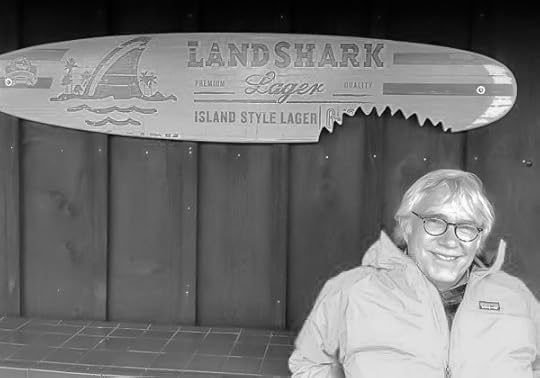
I’m finishing the second draft of The Big Aha today, and I’ll be sending it to my copy-editor/proofreader. I’d kind of forgotten how much work it is to write a novel. Who knows, this might be my last one.
The end of the Ruduoz Legend?
Well, once I’ve had eight months or a year off, I’ll probably want to jump back in.
August 13, 2013
More Gibberish About Genemodding
I wasn’t quite satisfied with last week’s post, “Genetic Engineering With An SF Interface.”
At this point I’m into revising the fourth out of fifteen first-draft chapters of my novel The Big Aha. And I have some lingering questions about how my characters go about tweaking the “nurbs,” which are the biomodded or tweaked organisms of the future—pretty much used in place of any of the manufactured things we currently use.

There’s also some stuff called nurb gel, which is a kind of primordial slime or universal tissue that can be converted into nurbs.
And my characters have acquired something they call “qwet” for “quantum wetware.” It allows them to get their minds into a cosmic mode, which feel fairly psychedelic, and which allows for telepathy or teep with other qwet people. Nurbs can get qwet too.
I’m interested in how the coming of qwet makes a difference in how we manipulate our nurbs. I’ve organized this installment (extracted from my Notes For The Big Aha volume) into a Q and A format. I realize it’ll seem a little cryptic, but you might have a little fun with it. As usual, I’m sticking in a bunch of my photos.

Q: How can the coming of qwet (that is, quantum wetware) make a difference in how we shapeshift our genetically engineered nurbs?
A: Thus far, all I’ve had qwet doing for us was giving us teep (or telepathy) and making us high. It would be good if qwet also had some more techie kind of effect. So let’s say that it allows you do to a vast and nontraditional computation in your head by staying in cosmic mode for a longer period of time, and thus solve the genemod design problem in your head, that is, the problem of figuring out the correct DNA changes needed to give a biotweaked organism some particular properties.
No need to explicitly call this mental process a “quantum computation,” as that phrase is a little tired. I might equally well call it a cosmic computation. Or cosmic logic, yeah baby. (Reminds me of a salon in Santa Cruz called “Hair Logic.” Only kind of logic you’re gonna get in Cruz…)
Anyway, once qwet gives you access to cosmic logic, you can indeed figure out how a genemod design (a.k.a. a DNA retrofit) in your head. And then you use your qwet teep to do the genemod installation, that is, you put the changes down onto every DNA molecule in the nurb’s body.
By the way, a quantum scientist might object that, if teep is always oblivious, then there could a bit of a problem with teep-tweaking a nurb, as this seems to entail transmitting permanent information via the teep link, in that you are literally “writing” something into its DNA—and this might meant you’re sending a signal faster than light. But I can somewhat undercut the objection by saying that you’re really just convincing the nurb to want to look a certain way once it gets around to it, and that the effects aren’t instantaneous. Or I might say that qwet teep works via a higher-dimensional channel to which the the usual signal-speed strictures don’t apply.

Q: How does genemod installation work?
A: The basic idea is that, by using quantum entanglement, you apply a genemod to every single cell of a receptive nurb.
The genemodding process works via a cascade of quantum vortices into the target organism’s cells. Like a tornado that fractally spawns sub- and subsub- and subsubsubtornadoes and so on, all the way to a molecule-sized force fields that reaches into the individual cells and alters their DNA.
In the pre-qwet days, people used a tool for this, an old-school machine. Call it a genemodder wand.
But now we qwetties can do it by looking at nurbs and getting into harmony with them. When you do this, you experience a mental image like that tornado-spawning process I just described.
To smooth the way for the installation, we’ll assume that the target nurb has been made qwet. Someone might argue that this isn’t necessary, given that we were able to use genemodder wands to install genemods even when the nurbs weren’t qwet. But perhaps the genemodders used a great deal of energy, and in order for the low-energy emanations of a human brain to be efficacious we can require that the target nurb indeed by qwet. Makes things more symmetric. You qwet a nurb and think things at it.

Q: Who invented the technique of using cosmic logic for genemod designs and qwet teep for installing the genemods?
A: Junko Shimano and Loulou Sass. Junko gets most of the credit, as she has a Stanford degree in Wetware Engineering, whereas Loulou is more like a carnie or a punk.

Q: Why does The Big Aha involve shapeshifting our nurbs?
A: The idea sort of started with Loulou’s Levolver game, a public realtime competition to design the coolest nurb, starting with a blank, accessible wad of nurb gel. I invented the game mainly so I could give Loulou an interesting skill. And working out its details is causing me this huge amount lot of trouble. I could just drop the Levolver game, but at this point I’d rather not.
And in any case, shapeshifting a nurb is also part of Zad’s eventual artistic process. in the old days when they did DNA retrofitting with a genemodder wand, Zad didn’t know how to mod a nurb. But now, in the new age of qwet teep genemodding, Zad can remodel a nurb—or build one from scratch out of nurb gel. And this opens up a new art career for him.
I also have a scene where Loulou does a genemod on an earring in Ned’s store. And someone might do this to the flying jellyfish nurbs, later on. Or try to. Note that a nurb doesn’t have to do what you tell it to. It might be in some sense “inaccessible” so that you can’t possibly genemod it. See the question after next for more on this point.
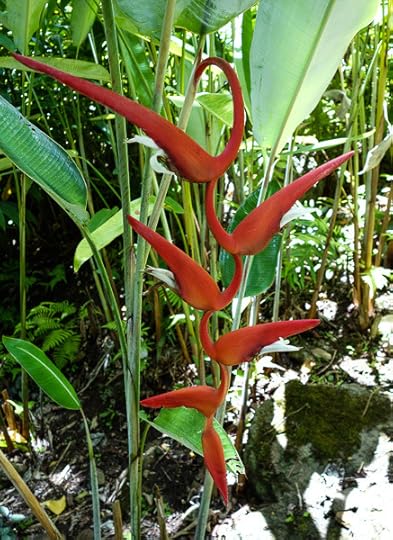
Q: What about the self-shapeshifting done by the mover nurbs and by Zad’s nurb copy, SubZad?
A: True shapeshifting is always done via DNA retrofitting, that is, via genemodding. But some nurbs do enjoy a weaker type of shapeshifting—via internal springs. This isn’t really so different from the fact that a human can “change shape” by flexing muscles and bending joints.
Gurky’s mover nurbs are shapeshifters in that weak sense of using internal springs. Or of flipping into one of several stable modes, like a Zeeman catastrophe machines. Yes, I did have Craig turning one of movers into a ball. But that’s not so different from a person squatting down.
I’ll call the mover nurbs “golems,” as that’s a colorful word, but I won’t use that word for any other kinds of nurbs.
SubZad can shapeshift his arms, making them long. I was thinking of him as being like the comic book Plastic Man, or like the Barbapapas in the kids’ books. But let’s say we’re doing this special arm-stretch via internal springs as well, akin to the stretching of an octopus’s tentacles.
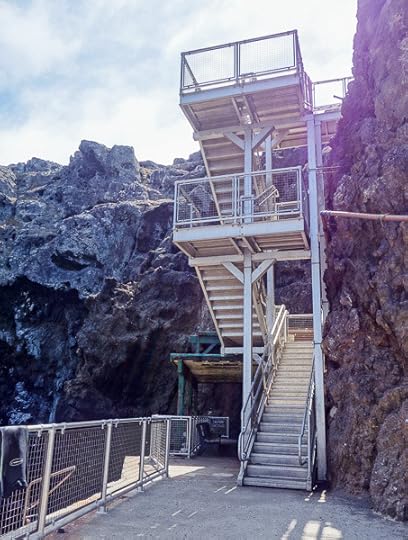
Q: How do we prevent mischievous or terroristic genemods from being installed upon people, animals and nurbs?
A: This is crucial. It must be impossible to tweak the DNA of very important kinds of nurbs such as house trees. You don’t want some nut to abruptly collapse a well-populated hundred-story house tree into a flat patch of lichen and thereby kill everyone in the building. You also don’t want people to be tweaking your own personal DNA against your will.
So we’d need two kinds of nurbs: tweakable and nontweakable. Accessible or inaccessible. Raw nurb gel is accessible, which is why you can make it into whatever you like. Commercial nurbs—like horns of plenty or roadspiders—are generally inaccessible.
But some commercial nurbs, such as jewelry, are accessible. There can be weak access restrictions, akin to write permissions on a computer file. Usually the write permission on an accessible nurb is limited so that only the owners (or the owner-approved agents) can redesign them at will. Akin sunglasses whose tint an optician can change.
To make the write-permission be fairly secure, we can suppose that a nurb knows its unique owner—not as a number or a name but as a personality with an accompanying DNA signature.
Living natural organisms are by default inaccessible. Being accessible is the exception, not the rule. You can’t ever make a inaccessible nurb or organism become accessible. But you can permanently make an accessible nurb become inaccessible. It’s a one-way irreversible transformation. Like an amputation.
The inaccessible/accessible distinction applies whether you’re trying to tweak the nurb with an older genemodder wand or with the newer process of qwet teep.
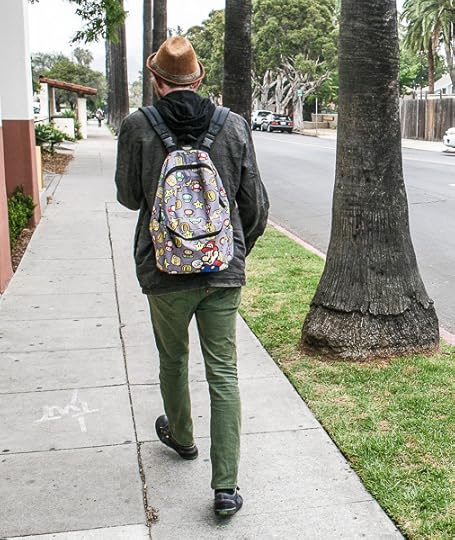
Q: What does it mean for a nurb’s DNA to be accessible? Why is it impossible to make an inaccessible nurb become accessible? Why is naturally occurring DNA always inaccessible?
A: A DNA molecule being accessible means it’s possible to get into a quantum entanglement with it.
Accessibility is a physical property, not a software encryption trick.
I’m imagining something like a little antenna on the DNA. It’s not a naturally-occurring thing. Let’s think of the antenna as something four-dimensional, like the Mophone antennas in Spaceland. I wouldn’t want to say much about the higher-dimensionality of the tweak antennas in the novel; I don’t want to push the readers too hard. But a 4D antenna is a reasonable concept within the framework of The Big Aha, where our universe is immersed in N-space, with a parallel partner universe not so far away, and with completely different island universes out there as well. So why not take advantage of this SFnal bounty?
Anyway, if you try and attach one of these antennas to a normal strand of DNA, you’ll end up breaking the DNA and killing the cell. You can only have the antenna if it was designed into the component base-pairs of the DNA. And it is fairly easy to break off the antennas without hurting the DNA>
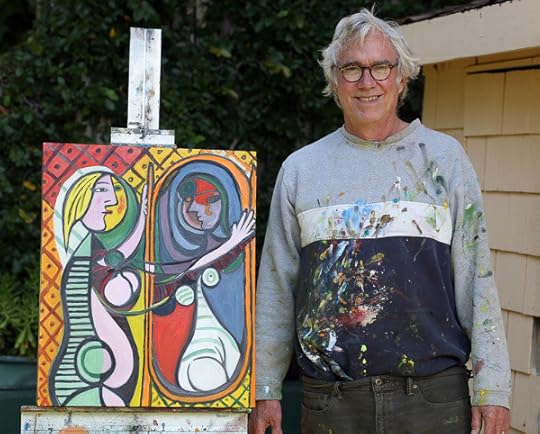
Q. What is nurb gel?
A. It’s a wad of amoebas or maybe slime-mold cells. Nurbs. With DNA antennas, that is, fully accessible. Zad used some nurb gel with a color interface as paint. And you can use nurb gel as a universal modeling clay. Zad makes nurbs like the Mr. Normals and the SubZad out of it. Let’s remember that Zad’s abilities to design or to shapeshift nurb gel only developed after he became qwet and gained the ability to use cosmic logic to design tweaks, and gained the ability to install the genemods via qwet teep with the gel.

[Skate shop in Santa Barbara, CA]
Q:What happens when Gaven tries to turn a cattail into a hot dog?
A: Gaven’s shoots out a qwetter beam, and thinks he can use qwet teep to install some meaty genemods onto the cattails. But you can’t genemod natural organisms. They’re permanently inaccessible. Their DNA has no antennas. Being more of a biz guy than a techie, Gaven didn’t understand this.
Perhaps, as an unexpected and comic side-effect, Gaven’s effort does take effect on some accessible nurb gel that happens to be at the picnic. Let’s say Zad had brought a little cup of nurb gel in hopes of making a small painting to impress everyone. And his paint crawls out of his paint tub and is a hot dog. Mild amusement ensues.
August 10, 2013
Genetic Engineering with an SF Interface
Today I finished a new painting called “Study of Picasso’s Girl Before A Mirror.” Lots of work, so many details kept unfolding. Took six or seven sessions. For the last session, I put the original out of sight and focused on making my version smooth and balanced. Fun. Maybe now I’ll try doing a painting (not a copy) in the Master’s style.

“Study of Picasso’s Girl Before A Mirror,” oil on canvas, August, 2013, 20” x 24”. Click for a larger version of the painting.
I don’t want to sell the Picasso painting for awhile, want to enjoy having it around, but I’m discounting the prices of my other paintings for a summer/fall sale, check it out if you’re interested.
Now to the meat of today’s post. Biotweaking. Illustrated, as usual, with whatever photos I have kicking around.
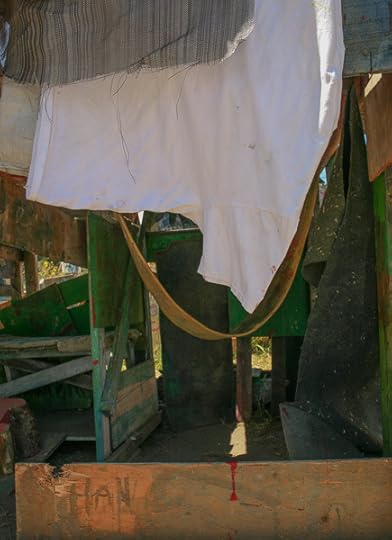
In my forthcoming novel The Big Aha our society is using biotweaked plants and animals in place pretty much every type of manufactured good. They call these things nurbs, no particular reason for that, I just like the word (which also has an unrelated meaning in computer graphics, but never mind that.)
One of the difficult things with genetic engineering is going to be figuring out how to make the correct DNA change in order to accomplish some specified alteration to an organism’s body—let’s call this “retrofitting the DNA.”
Unless I’m mistaken, from a computer science standpoint, retrofitting DNA is what they call a computationally unsolvable problem, meaning that there’s no possible algorithm for automatically doing it. The cause of this unsolvability is that there’s no general shortcut for predicting the effects of a specific DNA change—short of putting in the change and regrowing the organism. And, if you’re trying to pick out a desired change from an ensemble of changes whose effects are unpredictable—well, then you’re looking at an unsolvable problem.

But I’m writing a science-fiction novel here, so I’m not going to let this problem stop me. I’ll get around it by invoking one of currently fashionable SF “bogosity generators,” to wit, quantum computation. In an idealized SFictional world, quantum computers can carry out vast parallel computations, and thereby finesse any trouble with formally unsolvable problems.
If I’ve solved the DNA retrofitting problem, then I can make an automatic process that converts high-level changes into DNA changes. It’s a little like a Lamarckian inheritance process—changes to nurb’s body go right down into its DNA and you can clone off nurbs with those same new properties. And quantum computation handles the thorny puzzle of figuring out what precise DNA changes will replicate some externally imposed change in a nurb’s body.
Once you retrofit a nurb’s DNA, you’d need to execute a biological refresh function, regenerating or regrowing all of the nurb’s body, as if by a web-page refresh on a computer screen. Science-fictionally, you can image the refresh happening quite rapidly, like a ripple passing across the organism’s body.

So what we need is:
(Retrofitting DNA Design) quantum computation trick for figuring out DNA changes to reflect desired high-level changes in an organism,
(Parallel DNA Tweaking) an ability to remotely tweak all trillion of a nurb’s cells at once,
(Bio Refresh) a built-in ability for nurbs to refresh themselves like a web page, re-biocomputing their forms from their altered DNA.
As I said, you can do the “Retrofitting DNA Design” with a quantum computer. And you can do the Parallel DNA Tweaking and the Bio Refresh with a so-called tweaker virus that might be, let us say, based on the harmaline molecule—recall Terence McKenna’s fantasy that his use of yage and psilocybin in concert had placed a tiny radio-receiver into each of his body’s cells. I miss Terence.
Anyway, once all this working, you design a web-based tweaker interface that, experientially, feels as if you are molding your nurb with virtual hands—the interface is turning your shape requests into DNA changes and applying the changes to the target organisms’ cells. And the Bio Refresh function, repeatedly invoked, gives you realtime feedback on what your DNA alterations are doing. So it’s like working with paint or with clay.

SF writing advice to self: Load on the miracles, but keep the explanations simple. All I really want is consistency, ease and flash. And be glad I’m not working as a scientist.
August 3, 2013
My Dive Log, 1995-2009
By way of celebrating my completion of the first draft of my novel The Big Aha, I decided to do something completely unrelated.
I’ve typed up my dive log book entries from 1995-2009 and I’m posting them here, surrealistically illustrated by my usual random accumulation of utterly unrelated recent photos. Well, not utterly unrelated, as most of the images are of ocean or island scenes, including a few from a recent trip we made to Anacapa Island in the Channel Islands in Southern California
My “dive log book,” started in the very nearly pre-digital days of 1995, is a tiny, cheap spiral vest-pocket notebook, very weathered and water-stained by now. Before it utterly disintegrates, I thought I’d digitize the contents.
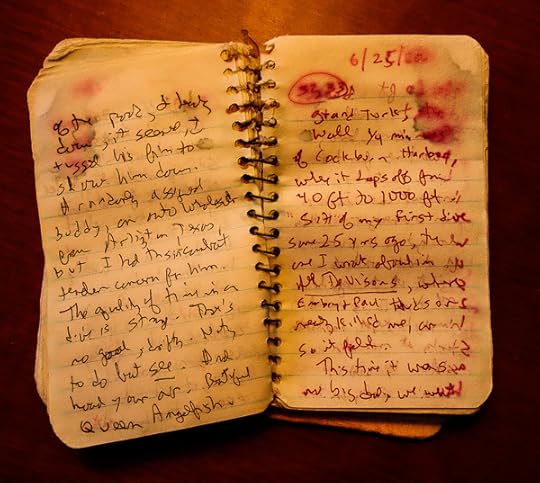
In the past I also blogged about some of these dives, and if you get really curious about some spot, you can try using my blog search box to find an entry that mentions it.
It’s worth mentioning that my dive experiences have found their way into many of my SF novels and stories. I think in particular of Realware, Mathematicians in Love, Spaceland, Hylozoic, and Jim and the Flims. To me, nothing is more purely alien than a marine invertebrate, and nothing is more like floating in space (or in hyperspace) than a scuba dive. And some of my paintings have submarine themes as well.
Dive Log Book, Rudy Rucker, 1995-2009

6/15/95
10 am. Lovers Cove, Monterey. Buddy named Penny. 18 ft/29 min. 49º. Gumboot chitons. 2900-1000. 11:15 am. 28 ft. 28 min. Rockfish. 2400 lb air to 1000.
6/11/95
8:30 am. San Carlos Beach, Monterey. 52 ft/27 min. 45º. Metridium Fields. Plumose Anemones. Sea Pen. 2400-300. 10:30 am. Breakwater, Monterey. Buddies Penny & Mark. 46 ft/24 min. Sheep Crab. Mating nudibranchs. Seals. Turbid. 2400 lb air to 450.
6/23/95
10 am. Tunnels Beach, Kauai. Rudy Jr. & Jeanette. 52 ft /40 min. 45 ft/42 min. Parrot fish slime cocoon, caves & tunnels, wrasse, candycane shrimp, stingray, Spanish dancer nudibranch. 3000 lb air to 500. Shorty 1/8” wetsuit, 16 lb. weights.

6/24/95
Morning. Poipu boat dive, Kauai. “Bubbles Below.” 40 ft/45 min. 50 ft./45 min. Octopus, underwater current, lots of sea turtles.
10/14/95
Afternoon. Butterfly house, Carmel. Solo dive, panic. Big tank, inadequate weight 24 lb. Scary diving pale seal near me, thought it was a shark. Got tangled in kelp after coming up in wrong inlet. I now see why solo dives are a bad idea! 50 ft/30 min.
1/15/96
Chilleno Bay, Mexico. Boat dive with guide “Leo,” me the only customer. 26 lb. weights, full wetsuit, 3000 lb air. 36 min/70 ft. Guide Leo. Moray eel. Schools of yellow fish. Sea fans and sponges. Visibility ~20 ft. Rocky. Used all the remaining air during safety stop.
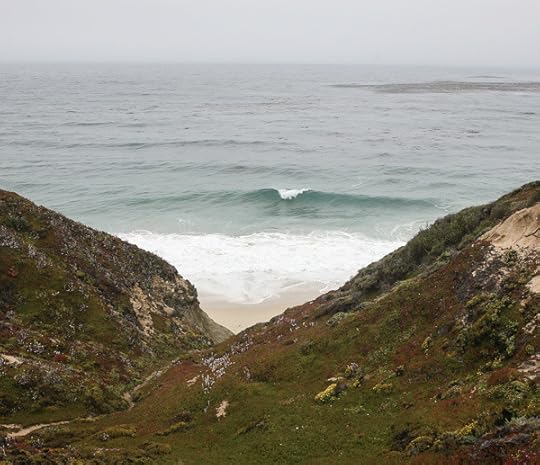
7/24/96
Vava’u Island, Tonga. Boat dive with guide Paul of “Beluga Diving.” I was their very first customer. 66 ft/30 min. Weight 13 kg, a bit light. Tongaseka Island, steep cliffs, underwater caves, a white-tip shark. 60 ft/30 min. 14 kg better. Tank valve not fully turned on, my air stopped flowing halfway through the dive, I used Paul’s octopus regulator to breathe, he got my valve open. Dealt with it okay, kind of glad to see I could survive a crisis. A’a Island.
7/20/96
Lifau Island, Haa’pai Islands, Kingdom of Tonga. Guide Roland. 200 bar pressure tank. 45 ft/40 min. Reef 6 km out from shore. A small shark, a big wrasse. Came out and saw whales, a mother and child. 45 ft/40 min. A reef closer in. Great visibility. We wend into lots of caves. Sea fans. A lobster. I hefted a giant clam 3 feet across. Its mantle was mottled like camouflage material. So many new kinds of fish.
8/2/96
Vuna Reef, Taveuni, Fiji. Boat dive, 8 people. 200 bar tanks. Shorty 5 mil suit. Hood on. 70 ft./30 min. Eagle ray big with spots. I had a problem with too much buoyancy, holding onto the bottom. 50 ft/30 min. Turtle. Soft coral that turned white when I brushed against it—the polyps withdraw. Outside a reef on a wall going 200 ft down. 40 ft. visibility. I swam too fast, ran out of air firs. The guide made me go the surface when I het 50 bar of pressure.
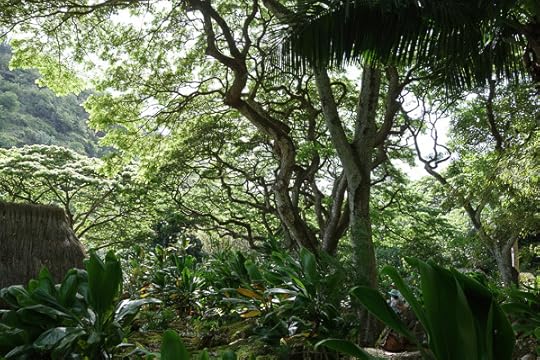
8/7/96
Taveuni, Fiji. Rainbow Reef Dives. 80 ft/40 min. Yellow Tunnel. Fairyland of fish and soft coral, red yellow purple blue. Insanely strong current, like fighting a hurricane across top of reef. Needed gloves. 3500 lb of air, used it all. 100ft/49 min. Great White Wall. My buddy saw a hammerhead shark, I was looking the other way. I found a 5 foot Moray eel. The wall went down and down. I got nitrogen narcosis at 100 ft and almost kept going down. Too deep. White corals (soft) down there, then light blue. 15 lb weights, shorty wetsuit with long sleeves.
8/2/97
Kawaihae, South Kohala, Big Island, Hawaii. With a guide from Ocean Sports/ Kohala Dive Shop. Shorty 3 mil long-sleeve suit, with gloves. Two dives. 50 ft/45 min. 40 ft/45 min. 3100 lb tanks. No air problems, I breathed slow. Used my breath to go up and down over coral instead of kicking. Small bright fish, butterfly tangs, surgeonfish. Saw a small spotted Moray eel, a puffer fish. Guide caught an octopus. Saw a helmet shell conch “attacking” a sea urchin in slow motion. A huge algae spore, supposedly one cell.
8/5/97
Puako, Big Island, Hawaii. Just me with guide Benjamin from Ecotropic Divers. Dove next to Neil Young’s Hawaii house. First dive to 87 feet. A garden of eels next to the continental shelf. An extremely big fish looming in the background. Very mysterious. Spacey. I wanted to go deeper. The guide said the biig thing behind the eel garden was a giant puffer fish. Second dive 40 ft. Lava caves. Big trumpet fish, maybe 6 feet long. A big “7-11” crab. Nudibranch. A pair of mating humuhumunukunukuapua’a fish. Leaky mask, leaky octopus valve. Came out in breaking surf with guide, scary.

6/16/98
Tunnels beach, Kauai. Beach dive, guided by Craig of Hanalei Watersports. 40 ft. Stayed near the very first drop, about twenty feet from shore, the guide had a problem with a novice diver from Uzbekistan, she panicked, and repeatedly swam up to the surface. Water turbid. Rudy Jr. along, he got bored and poked his head into a cave. The guide got mad at everyone. He ended the dive and we still had 1,500 pounds of air. The worst dive ever, although fun to be doing it with Rudy Jr. I did see a nudibranch egg ribbon rose.
6/18/98
Tunnels beach, Kauai. With Justin of Ocean Quest (run by George and Jeanette), and one other certified diver. Justin was a surfer from UCSC. 50 ft/47 min. Tunnels wall and coves. 50 ft/61 min. Swam to reef outside of Tunnels. Used dive computer. Turtle sleeping on bottom. Banded coral shrimp—we tried to get it to crawl in our mouths and clean them. Spiny lobsters in a cave. “Spaceship Cave” at outer reef, shafts of light. Good neutral buoyancy. Nice dive.
1/6/00
Presidente Hotel, Cozumel, Mexico. 30 ft. Solo beach dive. Went fine. Sponges with fairy shrimp in the holes. An eagle ray 6 feet across and thick as a fox in the middle. Black leopard spots on beige upper side, white underside. Empty condos in hotel. Strong current. A sunken small barge. I need bifocal lenses in my dive mask, can’t see closer than 4 feet. Huge shoal of silver fish. The guide said, “There’s no thermocline here,” meaning that it stays warmer deeper.
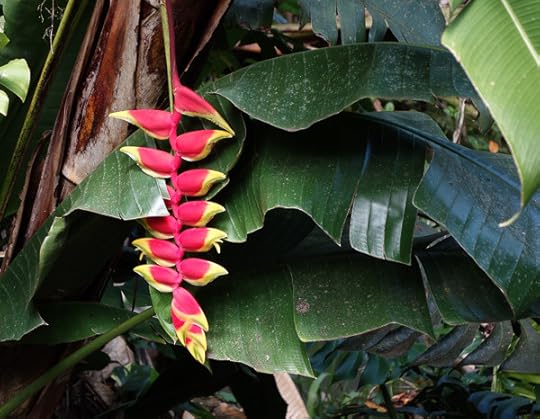
1/7/00
Cozumel, Q. Roo, Mexico. Scuba Du divers. Guide Beto. 90 ft. Palomar reef. Big sponges, no fish, in and out of holes. Drift dive. 3,500 psi to 700. 50 ft. La Ciedra. Strong current. Wore gloves for warmth. 17 lb weight. Next time bring own wetsuit. Huge barracuda. Grouper, parrot fish. A turtle, a shark. Cloud of little fish over coral head with all kinds of sponges shaped like: cone, fingers, heart, puckered bumps, snakes. Imagine that all are cross-sections of a single 4D form.
1/8/00
Cozumel, Mexico. Solo beach dive at our hotel Presidente. 30 ft. Went down and hung out with some coral heads near the shore first thing in the morning. Wore two shorty wetsuits over each other and took 20 lb weight, too much, needed to inflate BC. Moray, peacock flounder, soft coral, anemones. Brittle sea stars inside vase sponges. Brought home an “empty” conch shell, but a pitiful hermit crab started peeking out, hours later, so I threw him back into the sea. A good house never stays unoccupied.
1/9/00
Cozumel, Q. Roo, Mexico. Scuba Du boat dive. Columbia wall. 95 ft. I was looking at the cool way a soft coral wiggled in the wake of my flipper kick, really grokking the chaotic compound pendulum action, then looked at my gauge and it was just this—round thing with marks on it—numbers? Couldn’t tell if they were right side up and didn’t care, and then I knew that I was narced, and I eased up to 90 or to 85 feet and “I” was back. Wonderful huge sponges. My buddy used up his air too fast, and we had to go up early. 60 ft. Shallow drift dive, across the undersea wall, close to the wall, like skiing or sledding, like a dream of flight. I kept stressing about air and time and my buddy’s air, watching him thrash and blow wasteful clouds of bubbles—as if I could control it, feeling also some concern for him and when he seemed too far ahead of the pack and began heading down into the depth, I tugged his fin to slow him down. A randomly assigned buddy, an auto wholesaler from Arlington, Texas, but I had this partners-in-combat tender concern for him. Had lunch with him and his wife afterwards. The quality of time in a dive is strange. There’s no goal, it’s drifty. Nothing to do but see. And hoard your air. Saw some beautiful queen angelfish.
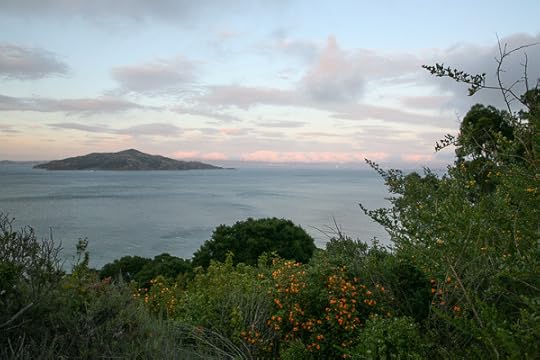
6/25/2001
Grand Turk Island, British West Indies Blue Water Dive ship, run by Mitch. Wall a quarter mile out of Cockburn Harbor. It drops from 40 ft to 1000 ft. Site of my first dive, some 25 years ago, the one I wrote about in my memoir All The Visions, where I nearly died or so I thought (mistakenly) for a few minutes. My nose was bleeding when I came up from our unwise dive to 100 ft with brother Embry, and our Viet-vet guide Paul told me it “It’s that air embolism I was warning you about. You only have a couple of minutes left.”). But this time it was no big deal, we went down to 60 ft. Only worry I had was that my overeager dive buddy wanted us to swim ahead out of sight of the guide. I didn’t let him lead me and he glared at me. An asshole. He used up all his air early on the 2nd dive, and then claimed that he only bailed out early because he didn’t want to pee in his wetsuit, which I doubt, as, realistically, who doesn’t pee in their wetsuit. Big deal. I saw some nice schools of tangs amid gorgonian sea fans, got a close look at some Christmas tree worms with my bifocal dive-mask lenses. The mask seems to leak, too bad. Wore a new shortie wetsuit and it was enough. Had an air problem myself on the first dive, sucked it up too fast. The 2nd dive I did fine. 40 lb weight.
6/27/2001
Grand Turk Island. Did the McDonald Arch and the Sand River with Mitch of Blue Water Dives. The dives were 45 min to 85 feet and 60 min to 60 feet. Mitch warned me that some other divers had complained about seeing me touch the coral and the sponges. I hadn’t realized this was such an issue, but I essayed not to touch anything this time. At the end, sat at the base of a coral head, looking up at a school of ten thousand little fish, me flicking my fingers to influence their motions.
6/28/2001
Grand Turk. Night dive. Blue Water Dives. The guide had an equipment problem and never got in the water, so it was fairly disorganized. 30-50 feet at the Library site. We had flashlights. It was cozy, not scary. Dark, calm, floating. Dreamy. Saw two Moray eels out of their holes, writhing along. Another diver’s Blue Water Dive pressure gauge blew out of its mount and all his air bubbled out. He wasn’t very deep, and just swam up. I saw a cute candy cane shrimp in a hidey-hole in the wall, like an off-duty nurse, gorgeous, alone at her apartment’s dining table.

6/29/2001
Grand Turk with Blue Water Dive. Did the Tunnel site. The guide had problems with his boat anchor. We entered a reef hole at 50 feet, came out at 75 feet. Embry was my partner, he was worried about clearing his ears, I think he had a cold, but it went fine. This was near our “Rudy is dying dive” twenty-five years ago. This time we dived down to 80 feet, and jokingly tried to push each other deeper. I had plenty of air.
6/30/2003
Lover’s Cove, Monterey, California. Bamboo Reef Dives. Beach dive, a tough schlep. One tank, one dive, 30 feet, 40 minutes. 34 pounds of weight. Stern, angry warnings from the seemingly obsessive diveshop owner not to pee in my rented wetsuit. Kelp forest, sea stars and some bagpipe-like creatures anchored at the bottom end and with two siphons.
2/11/2005
Yap Island, Micronesia, South Pacific. Beyond the Reef divers. Dive trip with brother Embry. Main Channel. Shortie wetsuit over dive skin, warm enough, but 12 pounds of weight, not enough. 1 hour, 45 feet. Lionfish, nudibranchs, sea cucumbers, Moorish idols (like angelfish), sea pen, clams in coral. I forgot to take off my BC when boarding after the dive. Rainy day, visibility so-so, not enough fish.
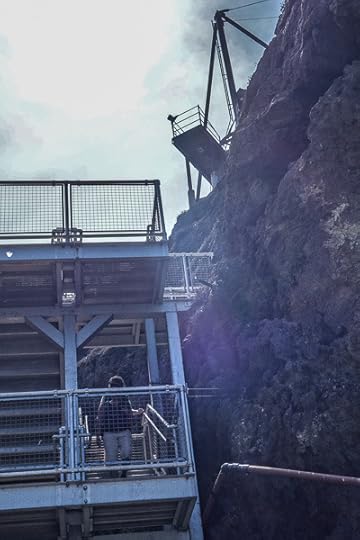
2/13/2005
Yap Island, Mi’il Channel, with Embry, Beyond the Reef divers. Two dives. Looked for mantas at 80 feet by a “cleaning station” where wrasses wait to chew parasites off the big mantas. No mantas today. Drifted along wall. Gorgeous “china shop” of shelf coral, acres of plates, beige green yellow pink purple, with Zhabotinsky-scroll edges. Very strong current. On second dive, I drifted half a mile after I came up to the surface, towards the open sea, a boat chased me down. Nobody was very worried about this, other than me. School of big gray fish by the undersea cliffs.
2/15/2005
Yap Island, me alone in an outboard with two guides who were chewing betel nut, they seemed fairly high Embry was off trying again to see some mantas. Shortie wetsuit, Aeroskin, 16 lb weights. I told my guides some of science-fiction plots and they liked that. Friendly guys. Two dives, both 70 feet max. Yap Caverns, Lionfish Wall, Gilman Wall. The caverns were really rifts and boulders. Bumphead parrotfish. Creamy white nudibranch with tendrils on its back. Schools of big jacks, a turtle, a shark, huge anenome with baby clown fish an eight of an inch long and with a larger parent guarding them.
2/17/2005
Palau, which is a separate country from Micronesia. Sam’s Tours. Embry and I rode on a dive boat to the end of the Palau archipelago. First dive, Coral Garden: mostly dead coral, thanks to global warming. Second dive, Turtle Wall: lots of turtles. A big flat bat-fish, eating the turtle’s crap. A big shark very close to us at about 80 feet. Fast current. We were flying along the wall, as if riding bicycles. We hit a thermocline, very cold water. Exhilarating, wonderful dive. Lots of soft coral. We turned back when the current changed and rode it back to the boat. Ran my air down to 100.
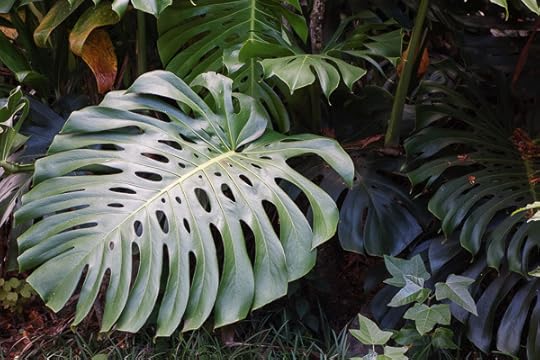
2/18/ 2005
Palau, Sam’s Tours. Two dives. A wall. Then Blue Holes, an immense cathedral-like space under a reef. The guide showed us a flashy little bivalve that he called a disco clam.
2/19/2005
Palau, Sam’s Tours, two dives. Again an hour’s boat ride each way. The first dive kind of a waste, looking for mantas who didn’t show. The second dive my best ever. Blue Corner. A whirlpool of big-eyed trevalleys far below us like a silver cyclone, the fish three and four feet long. Above us, outlined against the bright surface, a turtle and an eagle ray. Out to sea: dozens of sharks. Sublime. Infinite visibility. And on the way home we snorkeled Jellyfish Lake at the center of a tiny rock island. Millions of jellyfish in the sunlit algae-green water.
2/23/2005
Pohnpei, Kingdom of Micronesia. Embry and I in a skiff belonging to the Palau Village Hotel with a guide Tomo and two other tourists. Cut through a harbor and then through mangroves via Dawahk Passage, hit open sea. School of eighteen sharks, excellent. Divemaster uptight about my air, he sent me up with 500 lbs. Pelang Passage, again a problem with the divemaster, he sent up up with 800 lbs. Big sea cucumbers with leopard spots.
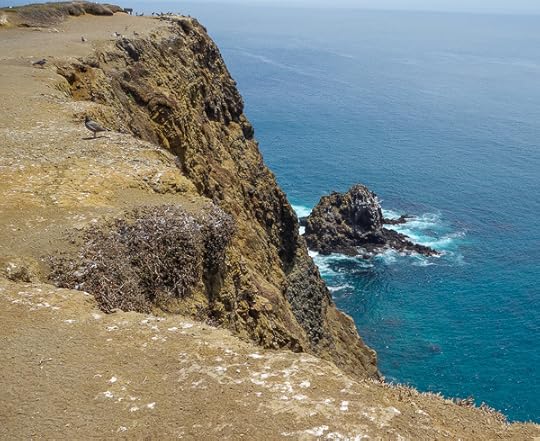
2/5/2005
Pohnpei. Embry and I with Palau Village Hotel guide and two others. Two big manta rays, 12 feet across, only 5 feet away from us, at a cleaning station, with the wrasses working on them. We watched for 30 minutes. Great. One of the manta crapped, and it diffused over us. Manta baptism. Second dive, shallow, drifting along a reef with fish and soft coral. Unspeakably beautiful and calm. No air pressure problems with guide today. 75 ft dive, came up with 100 lbs.
2/23/2006
Grand Turk, Blue Water Divers. 16 lb. Two dives, guide Mitch testing me for Open Water certification. First is McDonalds arch, 90 ft. Light nitrogen narcosis. Buoyancy drops at depth, and you have to swim up rather than drifting deeper. Narcosis always brings with it a sensation of, “I’m not deep enough yet.” Second dive a navigation dive, using a compass and counting my kicks. Count the left kicks only. Fifty kicks is about 200 feet. An eel garden with perhaps a thousand of them, projecting up from the sand, wobbly. Good boxfish. Big barracuda. Climbing out I dropped my weights in 90 feet of water, let them go.
2/25/2006
Grand Turk. 4/3 mil wetsuit over a dive skin. 16 pounds, 14 would have worked. A nature dive at Pillory Beach. Good step drop-off, schools of purple creole wrasses at 60 feet. Second dive, Coral Gardens. Gentle wall with five barracudas in a school. One by a vase sponge. I touched a food-begging grouper.
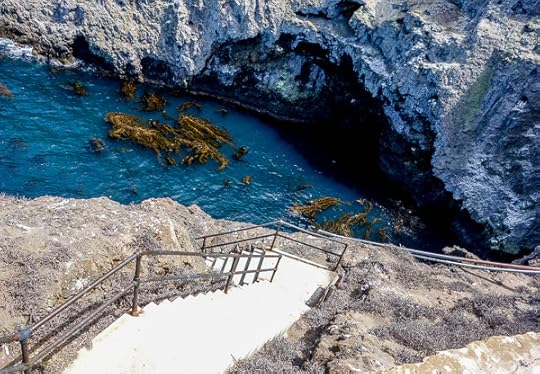
2/26/2006
Grand Turk. South side. Dive computer, 4 mil suit and vest, it was cold. First dive 90 ft. Windmills Wall. Sponges, lobster, moray. Second dive, saw three dolphins at start. 85 feet. Cold. Piers of the new cruise ship dock at 60 feet.
12/1/2006
Poor Knights Islands in New Zealand. Insanely cold water, 40 degrees. Wore a double wetsuit. Two dives. Saw sting rays, scorpion fish. Visibility terrible, about ten feet. Fifteen mile boat ride to the dive site. Mild cramps after the dive, the extreme cold was very stressful, I felt like I was going to die. Nearly puked on the bouncy ride back.
12/7/2009
Great Barrier Reef, Australia. On a liveaboard with my wife for three nights, sailing out of Cairns. Saxon Reef. Two dives along the reef, one left, one right. 60 feet max, mostly 30. Sharks, turtle, giant clam. Scared on first dive that my brain would pop, or that I’d forgotten how to dive. All OK.

12/8/2009
Great Barrier Reef. Pixie Pinnacle near Ribbon Reef. Dive 1: 60 ft, 45 min. A big cuttlefish, the size of a beagle. Veils of iridescent fish, like confetti. The Pixie Pinnacle is a solitary tower, we dove to the bottom and circled it as we rose upward, our paths like the stripes on a barber pole. Lots of fish, very bright. Dive 2: Cod Hole. Big fish. Rocky.
12/8/2009
Great Barrier Reef. Challenger Bay. Night dive. 50 min. Great. Spawning coral, sea lice, little shrimp in the coral with red, reflective eyes. Hundreds of trevalleys following our flashlights. Numerous smallish giant clams. Brittle sea stars. Clownfish in an anenome in a reef. Parrot fish.
12/9/2009
Great Barrier Reef. Pixie Wall. 80 ft, 45 min. Cold. Too much buoyancy. Another cuttlefish. Veils of fish. Along a wall low, came back high, ran out of air, floundering in choppy sea with partner, too tired to swim to dive boat, a small boat came to pick me up.
July 27, 2013
Interview: “User Interfaces of the Future”
The recent issue 13.2, June, 2013 of UX User Experience: The Magazine of the User Experience Professionals Association is on the theme SF and user interfaces. It includes interviews with me and with Bruce Sterling. You can see the table of contents for free online, but you would have to pay to join the UXPA in order to read the articles online—and you may want to.
In any case I’m free to publish the interview here myself, minus the UX edits. By the way, at any time, you can find nearly all of my email interviews in my massive compilation All the Interviews, which is now up to 382 questions long.
Anyway, here’s my version of the UX interview, with thanks to Aaron Marcus for providing the questions. (I’ll leave the Q & A numbers intact from my “All the Interviews” compilation.)
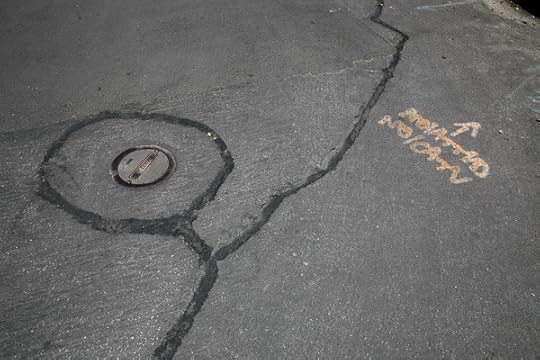
Q 377. You and fellow cyberpunk SF author Bruce Sterling were featured guest speakers in my plenary panel at CHI 1992, “Sci-Fi at CHI.” We talked about computer-human-interface design ideas in science-fiction. How has the SF scene evolved over the twenty years since then?
A 377. That was a fun con, Bruce and I shared a room. You guys had a reception in the Monterey Bay Aquarium. Bruce and I were so impressed by the tanks of jellyfish that we ended up coauthoring “Big Jelly,” an SF story about giant flying jellyfish. You can find the story free online as a sample of my collection, Complete Stories, distributed via my publishing company, Transreal Books.
I see the eventual SF default as being a future in which every kind of manufactured object has been replaced by a tweaked plant or animal.
“Big Jelly” was in fact a step towards that future, in that it’s about biotweak tech rather than about silicon machinery. SF writers ought to be writing a lot of stories about biotech these days, but that hasn’t fully kicked in. There’s an atavistic drift back to space operas with giant metal ships. Like writing SF novels about chariots or wooden ships or giant cars.
A different trend is that during the last decade we saw a lot of hype about the so-called Singularity, some of it with a weirdly religious fervor. The concept is that pretty soon AI will strike it rich, and computers will be as smart as humans. And then we’ll beef up the smart computers with more memory and faster chips, and they’ll design even smarter computers—and we’ll get into one of these exponential growth things. True-believing overweight mouse-potatoes will have their arteries cleaned out by nanomachines, and they’ll upload their minds onto robot bodies—which is actually an idea that dates back to my 1982 novel, Software.
The rank and file SF writers were baffled and uneasy about the Singularity, and for awhile they were leery of writing about it. But then Charles Stross rose to the challenge in his trail-blazing novel, Accelerando, and the rest of us piled on. I even wrote a novel called Postsingular, just to leapfrog over the whole thing. The singularity is SF. We’re telling plausible lies. Postsingular is available in ebook, paperback, and a free Creative Commons edition.

Q 378. How has your own work changed in terms of user-experience issues, that is, novel ways in which computer-based communication and interaction are imagined and/or described?
Q 378. For a number of years I’ve been writing about an interface device that I call an “uvvy,” which is pronounced to rhyme with “lovey-dovey.” It’s made of piezoplastic, that is a soft computational plastic. Thomas Pynchon had a substance like this in his novel, Gravity’s Rainbow—he called it imipolex, and I use this word in, for instance, my novel Freeware, which is a part of the Ware Tetralogy, available in ebook, paperback, and in a free Creative Commons edition.
An uvvy sits on the back of your neck and interfaces with your brain via electromagnetic waves interacting with the spinal cord—most users will want to stay away from interface probes that stick into them like wires. The uvvy functions like a smart phone, but it’s activated by subvocal speech and mental commands. It sends sounds and images into your brain.

Q 379. What do you think about how SF movies and television convey user-experience innovations?
Q 379. The hoariest media cliché for user interfaces is the “face on the wall,” that is, a TV-screen-like image that’s talking to you. But even with Skype and FaceTime, people don’t really seem to very interested in videophone communication.
A rich voice signal is more intimate and expresses more. Speaking of voice, I think the greatest weakness in the current digital smartphone standard is that digital voice isn’t anywhere nearly as rich as analog voice. Often, to save channel capacity, the signal drops when you’re not talking. I feel the digital audio channel needs to be made several bytes fatter, and it needs to be a continuous connection so that you hear the stage-setting buzz of the background noise and—also very important—the sound of the other person’s breath.
You often see 3D hologram displays being used in movie visualizations, and these can be fun, although they don’t tend to age well. My favorite media interface scenes are in the 1995 movie Johnny Mnemonic, based on a William Gibson story of the same name. Keanu Reeves does these wonderful Japanese-theater-type hand-jive moves when he’s manipulating his cyberspace interface. I never understood why this movie wasn’t more popular.
[By the way, in his own interview in UX User Experience, Bruce Sterling mentions that there’s a similar—and better-known—use of gestural interface in the more recent film Minority Report.]
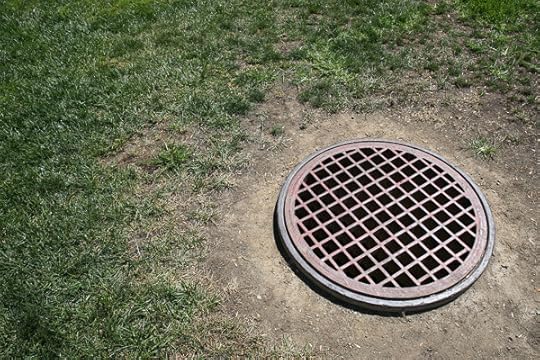
Q 380. Is there any particular aspect of current interface technology that you feel needs to be changed?
Q 380. It’s absurd to see people pecking at their tiny smartphone keyboards. This is so clearly a bad user interface. It’s unnatural, error-prone, isolating, and non-ergonomic.
If you’ve learned to touch type—and this should be a mandatory course in every middle school—then you can use a real keyboard without having to look at it. With a real keyboard, the words flow though your arms and onto the screen.
But there’s currently no good way to have a true keyboard on a smartphone. Sure, you can connect a portable full-size keyboard, but that’s kludgy. And you can, at least theoretically, have the device project a virtual keyboard onto your table top, but that’s going to have horrible ergonomics.
We need, I think, to take another step along the keyboard-virtualization route and get serious about having the device “see” the mock-keyboarding twitches of your fingers. At some point, a more ergonomic set of hand gestures could take hold. Along these lines, I think of the finger-squeezing interfaces that have been installed in the handle-grips of some experimental bicycles. Using your eight fingers gives you a byte per squeeze.
A different solution to the smartphone interface is to forget about hand gestures and go for voice recognition, and this technology seems to be maturing. One problem here is that you’re making noise in public, announcing texts that you might want to keep private. I do a lot of my writing on laptops in coffee shops, and I can’t imagine dictating my stories aloud—including all the corrections. I’d seem like a madman. Not that the people having cellphone conversations with earphones and dangling mikes don’t already seem dangerously insane. I suppose the next step might be to have the device lip read your subvocal speech, or pick up the vibrations from a throat mike.
I also need to say something about pointing devices—mice, track-balls, and touchpads. Over time, using any of these devices intensively is hideously damaging to your body—ask any author or programmer. It’s like a silent, unacknowledged industrial disease that attacks a relatively powerless underclass. Like black lung used to be for miners. We’ve seen demos where a computer camera tracks your eye movements and lets you point by looking. I don’t understand why this feature isn’t being perfected and rushed to market for every desktop, laptop, tablet and smartphone.
With all this said, I have a feeling that there’s some as-yet-unimagined solutions that we’ll be using in twenty or thirty years. Possibly we’ll get to an uvvy-style direct brain interface. But for sure we won’t be pecking at smartphone keys and ruining our bodies with computer mice.
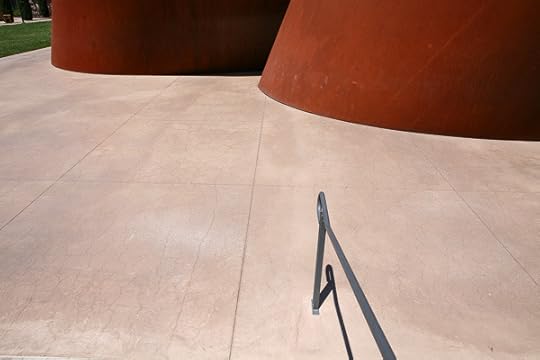
Q 381. What kind of user interface are you using in your latest novel Turing and Burroughs?
A 381. Telepathy. For me, that’s the gold standard, the interface that we’re really working towards. At a metaphorical level, telepathy stands for the dream of being perfectly understood by your friends and lovers. And we’re always getting closer.
Even though we tend to ignore this, even print is a first step towards telepathy, but time-delayed. You read this interview and you know what I’m thinking. The phone is another step. You’re speaking and listening to someone who’s far away. Speech is very intimate, very close to the roots of the mind.
An interesting aspect of full telepathy is that you can communicate info in a hyperlink style. When I have a big image to share, I don’t email the whole image, I simply send a hyperlink to the image’s location, and let the user find the image there. With telepathy, instead of wrestling some complicated thought pattern into words, you might simply send a trusted friend a “hyperlink” to the location of this thought within your brain. And possibly they can connect to you and experience the thought as if they’re having it themselves. Note also that with this style of communication no longer need to break down an image into RGB bytes, nor need you code a thought into words.
I’ve put telepathy into any number of my novels, using all sorts of SFictional gimmicks to make it work. In Turing and Burroughs, my characters experience a communicable biological mutation that makes them sensitive to a certain type of brain-generated wave. Also they can shapeshift into giant slugs and have great beatnik orgies.
As with many of my books, Turing and Burroughs is available in paperback, ebook, and free CC editions. Putting out my content. Building my brand.

[Photo by Sylvia Rucker]
Q 382. In the movie The Graduate (1967), the young hero is urged to focus on the future based on one word: plastics. If you were to guide newcomers to the world of the future, what would that one word be?
A 382. One word? Telepathy. Or a reasonable facsimile thereof. At least in terms of user interfaces.
In the tech realm, the answer is surely biotech.
And for a creative person trying to make a living, the key word might be disintermediation, that is providing your creative content directly to consumers. Self publishing, in other words. When you’re distributing things on the web, you want to avoid the various parasitic entities that might leech onto your slim income.
So, regarding the future, I’m suggesting that you be a creative content provider, and that you manage the distribution yourself. DIY, as the punks used to say.
UX Interview on “SF and User Interfaces of the Future”
The recent issue 13.2, June, 2013 of UX User Experience: The Magazine of the User Experience Professionals Association is on the theme SF and user interfaces. It includes interviews with me and with Bruce Sterling. You can see the table of contents for free online, but you would have to pay join the UXPA in order to read the articles online.
Fortunately I only gave them non-exclusive e-rights to my interview, so I’m free to publish it here myself. By the way, at any time, you can find nearly all of my email interviews in my massive compilation All the Interviews, which is now up to 382 questions long.
Anyway, here’s my own edit version of the UX interview, with thanks to Aaron Marcus for providing the questions. I’ll leave the Q & A numbers intact from my compilation.

Q 377. You and fellow cyberpunk SF author Bruce Sterling were featured guest speakers in my plenary panel at CHI 1992, “Sci-Fi at CHI.” We talked about computer-human-interface design ideas in science-fiction. How has the SF scene evolved over the twenty years since then?
A 377. That was a fun con, Bruce and I shared a room. You guys had a reception in the Monterey Bay Aquarium. Bruce and I were so impressed by the tanks of jellyfish that we ended up coauthoring “Big Jelly,” an SF story about giant flying jellyfish. You can find the story free online as a sample of my collection, Complete Stories, distributed via my publishing company, Transreal Books.
I see the eventual SF default as being a future in which every kind of manufactured object has been replaced by a tweaked plant or animal.
“Big Jelly” was in fact a step towards that future, in that it’s about biotweak tech rather than about silicon machinery. SF writers ought to be writing a lot of stories about biotech these days, but that hasn’t fully kicked in. There’s an atavistic drift back to space operas with giant metal ships. Like writing SF novels about chariots or wooden ships or giant cars.
A different trend is that during the last decade we saw a lot of hype about the so-called Singularity, some of it with a weirdly religious fervor. The concept is that pretty soon AI will strike it rich, and computers will be as smart as humans. And then we’ll beef up the smart computers with more memory and faster chips, and they’ll design even smarter computers—and we’ll get into one of these exponential growth things. True-believing overweight mouse-potatoes will have their arteries cleaned out by nanomachines, and they’ll upload their minds onto robot bodies—which is actually an idea that dates back to my 1982 novel, Software.
The rank and file SF writers were baffled and uneasy about the Singularity, and for awhile they were leery of writing about it. But then Charles Stross rose to the challenge in his trail-blazing novel, Accelerando, and the rest of us piled on. I even wrote a novel called Postsingular, just to leapfrog over the whole thing. The singularity is SF. We’re telling plausible lies. Postsingular is available in ebook, paperback, and a free Creative Commons edition.

Q 378. How has your own work changed in terms of user-experience issues, that is, novel ways in which computer-based communication and interaction are imagined and/or described?
Q 378. For a number of years I’ve been writing about an interface device that I call an “uvvy,” which is pronounced to rhyme with “lovey-dovey.” It’s made of piezoplastic, that is a soft computational plastic. Thomas Pynchon had a substance like this in his novel, Gravity’s Rainbow—he called it imipolex, and I use this word in, for instance, my novel Freeware, which is a part of the Ware Tetralogy, available in ebook, paperback, and in a free Creative Commons edition.
An uvvy sits on the back of your neck and interfaces with your brain via electromagnetic waves interacting with the spinal cord—most users will want to stay away from interface probes that stick into them like wires. The uvvy functions like a smart phone, but it’s activated by subvocal speech and mental commands. It sends sounds and images into your brain.

Q 379. What do you think about how SF movies and television convey user-experience innovations?
Q 379. The hoariest media cliché for user interfaces is the “face on the wall,” that is, a TV-screen-like image that’s talking to you. But even with Skype and FaceTime, people don’t really seem to very interested in videophone communication.
A rich voice signal is more intimate and expresses more. Speaking of voice, I think the greatest weakness in the current digital smartphone standard is that digital voice isn’t anywhere nearly as rich as analog voice. Often, to save channel capacity, the signal drops when you’re not talking. I feel the digital audio channel needs to be made several bytes fatter, and it needs to be a continuous connection so that you hear the stage-setting buzz of the background noise and—also very important—the sound of the other person’s breath.
You often see 3D hologram displays being used in movie visualizations, and these can be fun, although they don’t tend to age well. My favorite media interface scenes are in the 1995 movie Johnny Mnemonic, based on a William Gibson story of the same name. Keanu Reeves does these wonderful Japanese-theater-type hand-jive moves when he’s manipulating his cyberspace interface. I never understood why this movie wasn’t more popular.
[By the way, in his own interview in UX User Experience, Bruce Sterling mentions that there’s a similar—and better-known—use of gestural interface in the more recent film Minority Report.]

Q 380. Is there any particular aspect of current interface technology that you feel needs to be changed?
Q 380. It’s absurd to see people pecking at their tiny smartphone keyboards. This is so clearly a bad user interface. It’s unnatural, error-prone, isolating, and non-ergonomic.
If you’ve learned to touch type—and this should be a mandatory course in every middle school—then you can use a real keyboard without having to look at it. With a real keyboard, the words flow though your arms and onto the screen.
But there’s currently no good way to have a true keyboard on a smartphone. Sure, you can connect a portable full-size keyboard, but that’s kludgy. And you can, at least theoretically, have the device project a virtual keyboard onto your table top, but that’s going to have horrible ergonomics.
We need, I think, to take another step along the keyboard-virtualization route and get serious about having the device “see” the mock-keyboarding twitches of your fingers. At some point, a more ergonomic set of hand gestures could take hold. Along these lines, I think of the finger-squeezing interfaces that have been installed in the handle-grips of some experimental bicycles. Using your eight fingers gives you a byte per squeeze.
A different solution to the smartphone interface is to forget about hand gestures and go for voice recognition, and this technology seems to be maturing. One problem here is that you’re making noise in public, announcing texts that you might want to keep private. I do a lot of my writing on laptops in coffee shops, and I can’t imagine dictating my stories aloud—including all the corrections. I’d seem like a madman. Not that the people having cellphone conversations with earphones and dangling mikes don’t already seem dangerously insane. I suppose the next step might be to have the device lip read your subvocal speech, or pick up the vibrations from a throat mike.
I also need to say something about pointing devices—mice, track-balls, and touchpads. Over time, using any of these devices intensively is hideously damaging to your body—ask any author or programmer. It’s like a silent, unacknowledged industrial disease that attacks a relatively powerless underclass. Like black lung used to be for miners. We’ve seen demos where a computer camera tracks your eye movements and lets you point by looking. I don’t understand why this feature isn’t being perfected and rushed to market for every desktop, laptop, tablet and smartphone.
With all this said, I have a feeling that there’s some as-yet-unimagined solutions that we’ll be using in twenty or thirty years. Possibly we’ll get to an uvvy-style direct brain interface. But for sure we won’t be pecking at smartphone keys and ruining our bodies with computer mice.

Q 381. What kind of user interface are you using in your latest novel Turing and Burroughs?
A 381. Telepathy. For me, that’s the gold standard, the interface that we’re really working towards. At a metaphorical level, telepathy stands for the dream of being perfectly understood by your friends and lovers. And we’re always getting closer.
Even though we tend to ignore this, even print is a first step towards telepathy, but time-delayed. You read this interview and you know what I’m thinking. The phone is another step. You’re speaking and listening to someone who’s far away. Speech is very intimate, very close to the roots of the mind.
An interesting aspect of full telepathy is that you can communicate info in a hyperlink style. When I have a big image to share, I don’t email the whole image, I simply send a hyperlink to the image’s location, and let the user find the image there. With telepathy, instead of wrestling some complicated thought pattern into words, you might simply send a trusted friend a “hyperlink” to the location of this thought within your brain. And possibly they can connect to you and experience the thought as if they’re having it themselves. Note also that with this style of communication no longer need to break down an image into RGB bytes, nor need you code a thought into words.
I’ve put telepathy into any number of my novels, using all sorts of SFictional gimmicks to make it work. In Turing and Burroughs, my characters experience a communicable biological mutation that makes them sensitive to a certain type of brain-generated wave. Also they can shapeshift into giant slugs and have great beatnik orgies.
As with many of my books, Turing and Burroughs is available in paperback, ebook, and free CC editions. Putting out my content. Building my brand.

Q 382. In the movie The Graduate (1967), the young hero is urged to focus on the future based on one word: plastics. If you were to guide newcomers to the world of the future, what would that one word be?
A 382. One word? Telepathy. Or a reasonable facsimile thereof. At least in terms of user interfaces.
In the tech realm, the answer is surely biotech.
And for a creative person trying to make a living, the key word might be disintermediation, that is providing your creative content directly to consumers. Self publishing, in other words. When you’re distributing things on the web, you want to avoid the various parasitic entities that might leech onto your slim income.
So, regarding the future, I’m suggesting that you be a creative content provider, and that you manage the distribution yourself. DIY, as the punks used to say.
July 15, 2013
Gubs and Wormholes
I finished a new painting called “Gubs and Wormholes” this weekend, and I’m currently planning to use it on the cover of my novel The Big Aha. If I manage to raise a little more money, I’ll try and organize an art show and a launch party.
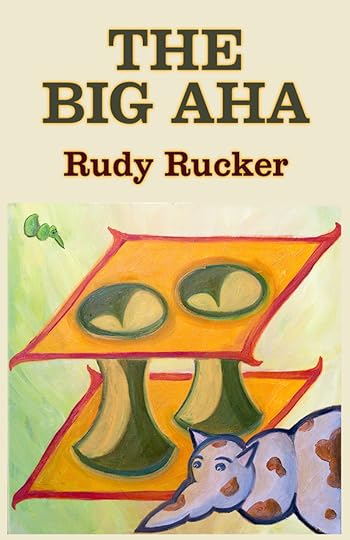
Draft Cover for The Big Aha based on “Gubs and Wormholes,” oil on canvas, July, 2013, 22” x 22”. Click for a larger version of the painting.
On Friday I got started on the final “Mother and Father” chapter of The Big Aha. The mother/father pair is:
(a) My married-couple characters Jane & Zad,
(b) My character Zad’s Mom & Dad,
(c) The green gub & the spotted gub shown in the cover image.
All three options at the same time. Plus the transreal echoes into my own life. It’s coming together very heavy and strange.
Just a few more scenes to write. And I know, more or less, what’s going to happen—although, as I always say, I never fully know until I’ve written the scenes. A novel-in-progress has its own hidden life.

I was influenced last week by Stephen King’s excellent novel 11/22/63, which has a lot of synchronicities and overlays. It’s a 340,000-word time-travel novel, and the hero keeps running into heavy harmonies. Here’s a nice passage where the narrator reacts to an intense coincidence:
“…when that happens you see that the world is barely there at all. Don’t we all secretly know this? It’s a perfectly balanced mechanism of shouts and echoes pretending to be wheels and cogs, a dreamclock chiming beneath a mystery-glass we call life. Behind it? Below it and around it? … A universe … surrounding a single lighted stage where mortals dance in defiance of the dark.”

Dancing with who? Your loved ones and your muse—but look out for the dragon.
July 10, 2013
Full Summer. Home Stretch of THE BIG AHA.
I’m on the home stretch of my novel The Big Aha. Getting great support from my Kickstarter backers. Very stoked.
I’ve been averaging 300 words a day for about a year, which means I’m up to 95,000 words, with the final target probably 100,000 words. I track these things, like a miser counting his coins. The 300 word average means that, on good days, I write 1,000 words, but there’s plenty of days when I don’t write at all.

Just a few more scenes to write. And I know, more or less, what’s going to happen—although I never fully know until I’ve written the scenes. The book has its own life.
I like to print out my latest draft and then maybe lie on a camping mat in a shady spot in the backyard marking it up and scribbling out a new scene. Then type that in, maybe on my laptop on the couch, print it out, and repeat the cycle.
I just finished Chapter 14: Churchill Downs. Featuring that giant “myoor” creature I painted last week. I did about ten or fifteen type/print/mark-up cycles on that chapter. Scribbled & typed papers accumulating like drifts of snow. When I totally can’t face the stress/joy of writing anymore, I get into a painting, go biking, go to SF, or go to Four Mile Beach north of Santa Cruz, photo above.
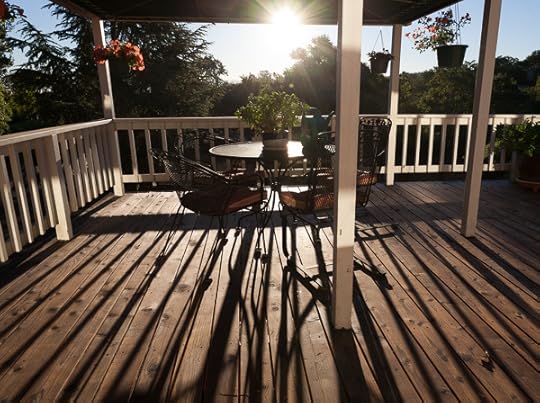
It’s full-on summer here in Silicon Valley. July. The very heart of it. I love this month. The yottawatt sun! Lurking inside in the afternoons, with the attic fan drawing up air from the cool basement.
On the over-98-degree days, we crank up the central AC for a couple of hours. But I don’t like AC. Makes me feel like I’m riding in an airplane. Or deaf. In Robotic Mode instead of Cosmic Mode—as the qrude characters say in The Big Aha.
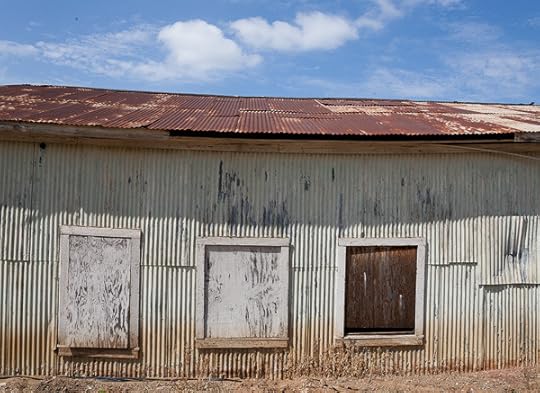
I’ll go out for walks in the dizzy heat, just for the intensity of it.

Talking to the plants and digging the gnarl. Clouds—can you imagine how excited people would be about clouds if for some reason they were rare and hard to see? All the things Nature gives us for free. If I can remember to see them.

Still happy about our blessed week in Hawaii. North Shore of Oahu. I’ve been emailing with my old Surfing-SF-story collaborator Marc Laidlaw. Maybe I’ll have time for more “Tales of the Tube” after The Big Aha.
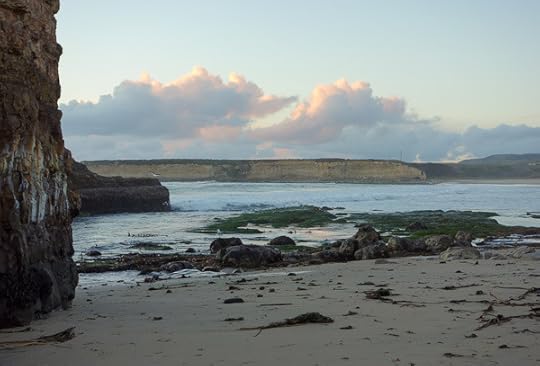
Back at Santa Cruz’s Four Mile Beach here in this picture. I often think of this spot as being where my muse lives. It’s near a stone tower at the south end of the beach. I always like to go here and write EADEM MUTATA RESURGO in the sand, which means “The same, yet changed, I arise again.” That’s an inscription on the gravestone of a mathematician, Jakob Bernoulli, who studied a famous type of spiral curve (the logarithmic spiral seen on seashells such as the nautilus, or the humble snails). It also appears in my novel Frek and the Elixir. For me, it’s an encouragement for writing yet another novel. Since Frek, I tend to write in the wet sand at a beach pretty much every time I’m working on a novel. Good luck…or an invocation of the muse.
In good old California it always cools off at night. Love it when I’m out at Santa Cruz in the evening. If I’m at home, I’ll often do one or two more mark-up/type/print cycles on a lounge chair in back. Obsessive cycles of work…you kind of need to get that way to actually finish a book.

Obsessive or not, I’m really having a good time with my characters and my settings and my aliens these days. I love the things they say. And—oh those gubs! I’ll miss the whole gang when I’m done. On the other hand, it’s been a long haul, and I’ll be glad to sail my whaling ship into port. Laden with gub oil, scrimshaw and ambergris.
July 1, 2013
Illustrating THE BIG AHA. “The Mr. Normals vs. The Myoor”
I finished another painting for my novel today, more info here: The Big Aha project. The new picture’s title is The Mr. Normals vs. The Myoor.
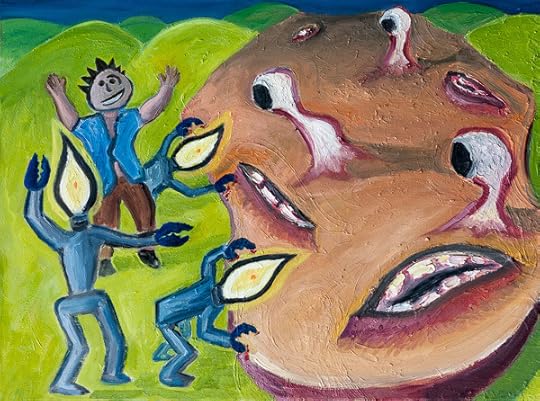
“The Mr. Normals vs. the Myoor,” oil on canvas, July, 2013, 24” x 18”. Click for a larger version of the image.
The picture has to do with a scene in the closing chapters of The Big Aha. My character Zad has created some creatures called Mr. Normals whom Zad has now sicced upon a sinister giant alien slug called a myoor. The myoor looks scared of them, which is good.
I made the Mr. Normals look like Gyro Gearloose’s Little Bulb in the old Donald Duck comics.
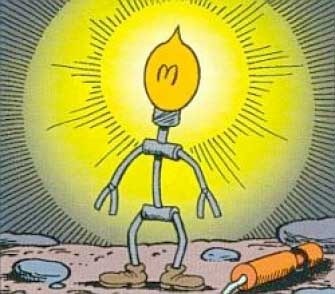
The other day I watched this very heavy Mexican SF movie called Sleep Dealer, which the cool Tucson artist Daniel Martin Diaz turned me onto recently. (Check out Diaz’s amazingly cyberdelic forthcoming book Soul of Science.)
The Sleep Dealer film’s is partly about the US taking advantage of Mexican workers. And the myoor is kind of flowing down across a border, and my Zad character looks kind of Latino in this painting, and I was also thinking about cross-border ethnic conflict here, so at another level the picture is a political parable…not that I would have a clear idea of what the Mr. Normal / Little Bulb figures would stand for under that interpretation.
But primarily the painting is about the events in The Big Aha. The way I painted Zad relates to two earlier paintings of him which I’ll reprint below, Louisville Artist and Night of Telepathy.
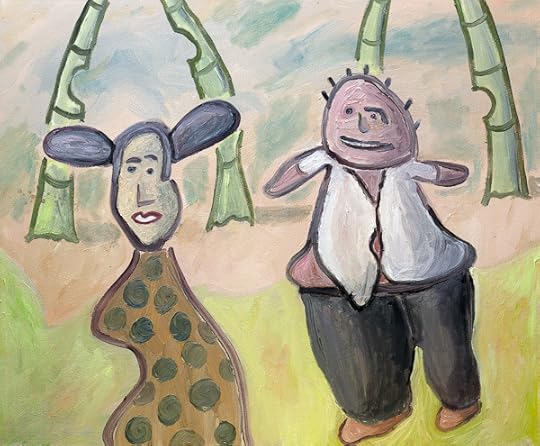
“Louisville Artist,” oil on canvas, October, 2012, 24” x 20”. Click for a larger version of the image.
The way I painted the Louisville artist is kind of a self-deprecating joke about my personal self-image, or about the public’s image of artists or writers.
I mention Louisville because I was born there and lived there till I was 17, at which point my parents moved away and I went off to college. The Big Aha novel is in fact set in Louisville. Those tall things in the background are “house trees” that people inhabit in the biotech future.
What about the woman? She’s the girlfriend, Loulou, whom Zad takes up with during a period of separation from his wife. I had fun giving Loulou a really odd hair-do. Kind of Princess Leia thing.
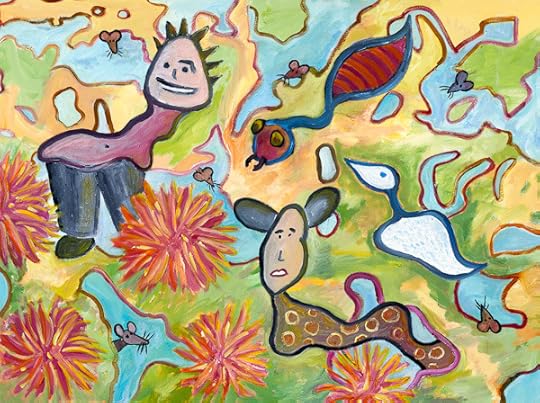
“Night of Telepathy,” oil on canvas, November, 2012, 40” x 30”. Click for a larger version of the image.
In this painting we see Zad and Loulou spending a night together in telepathic contact. What about those rats? Well, there happen to be a lot of intelligent rats in The Big Aha, thanks to “quantum wetware.”
And it’ll all seem perfectly logical in the end…
June 30, 2013
Hylozoic in Hawaii
Dig this 4 minute video that a UK guy made to illustrate one of my public talks about hylozoism.
You may or may not know that (a) I published a novel called Hylozoic, and (b) that hylozoism is an actual honest-to-goodness official Wikipedia-listed word meaning the philosophical view that everything is alive and conscious.
Unless I’m mistaken, the audio for the video is drawn from a TEDx talk I gave in Brussels in November, 2011.
The guy who made the new “Hylozoism” cartoon video is named either Andy Simon or Andy Harwood, and he’s studying video at a university in Bath. Quite awesome, uses old toons that feature living objects—and cartoons like this were a huge influence on me as a kid. Synchronistically enough, the video ends with me talking about “the big aha”! A nice poke in the ribs from the divine muse, that. Given that I’m spending all my time these days working to finish my next novel, The Big Aha.
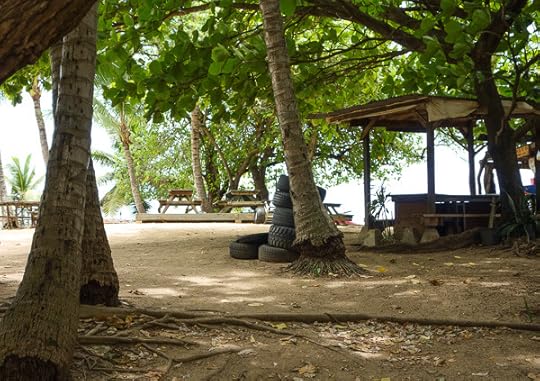
My family and I were on the North Shore of Oahu early this month, fourteen strong, with the kids, the spouses and the grandkids. I have a bunch of photos from there, and I’ll run a few of them today and, here and there, point out some hylozoism connections.

Banyan trees are fairly common on Oahu, I love these things, how they spread out and send now new trunks. They’re the very image of a futuristic biotech house that grows itself. We spent a couple of days in Honolulu, near a park just after Waikiki Beach, and quite a few homeless people were living in this park—specifically, many of them were making the banyan trees their home. Despite Hawaii’s image as a vacation paradise, they have a very large homeless population. One guy told me that Hawaii doesn’t really have a middle class. A few rich people and a lot of poor people.

Anyway the Honoluluans use the park for all kinds of things. I saw a yoga class there as well.
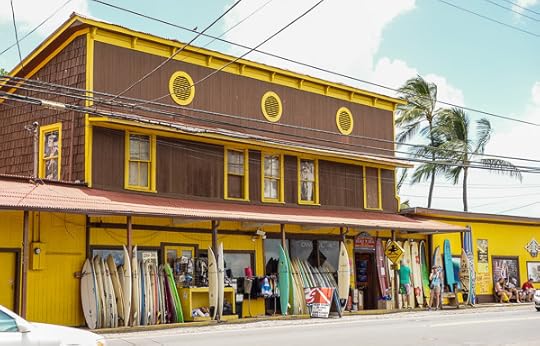
Up on the North Shore, it’s all about surfing. You see surfers doing yard work or working as gardeners just so they can live there, waiting for the Banzai Pipeline type surf in the winter. Saw this cool surf shop in Hale’iwa.
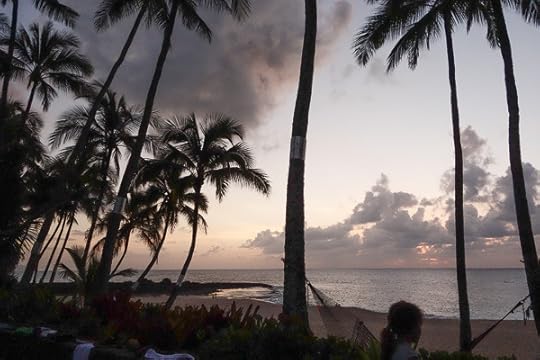
We were staying in fairly old and beat-up bunch of cottages, very calm and mellow with nothing but a couple of super high palm trees between us and the beach.
Add in a sunset, and oh, baby.
One day we went to the Waimea Falls park, right by Waimea Beach, famed for it’s forty foot waves.
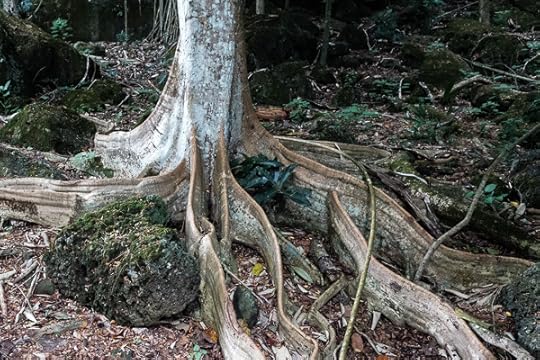
The park had all these great plants. The plants that sit around in bank lobby or top of your fridge or on your bathroom counter—those plants are dreaming of going to the tropics and getting big.
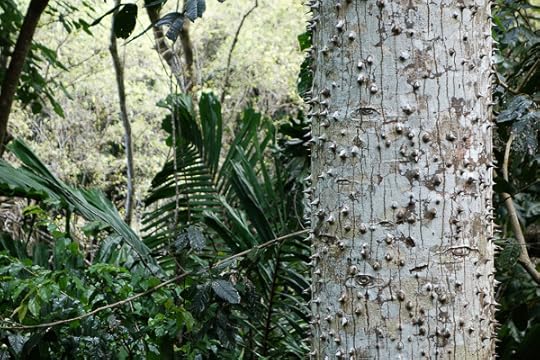
This one tree was all covered with thorns, scientific name Bombacopsis Quinata. Common name Don’t Climb Me.
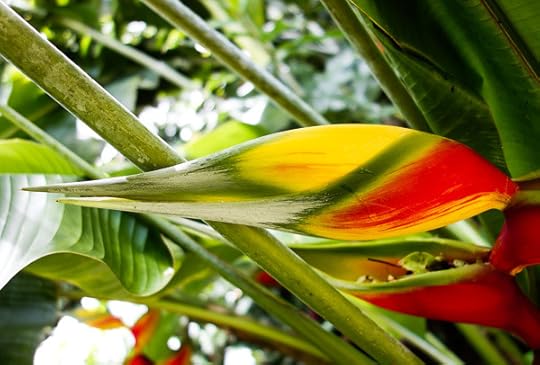
I like how this heliconia looks like a tropical bird or fish. Everything alive in teh same kind of way. I was kind of lost in the park for half an hour, dazed by the heat and humidity, intoxicated by the scents of flowers, wandering around very very very slowly. Like a butterfly. Everything alive, even the rocks. Paradise.

The actual Waiamea falls were great. We were about the first people of the day to get up there. Some mellow Hawaiian rangers/surfers were there to give us all life-jackets. We swam across a deep rocky pool to this hundred foot waterfall pounding into the pool. With some effort you could get under the fall, find handholds in the rock, and pull yourself up so that your head went through the waterfall and maybe a little further to the legendary breathing space behind the fall. Where gnomes always hid their gold.
I hung in there for a very long and wonderful minute, letting the water pound onto my skull and my shoulders, and it felt like time rushing past, like a cascade of thoughts and memories, like fire, like the big aha and the White Light.

When I get out, I feel really high and wonderful. I babbled a little about it to one of the cool young guys handing out life jackets, telling him that I’d seen everything in the falls, and he looked at me closely and nodded. “You saw the fire?” he said, then added, “I’ve seen it too. They used to build ritual fires on a platform in there.” He gave me a friendly, brotherly nudge and sent me on my way.
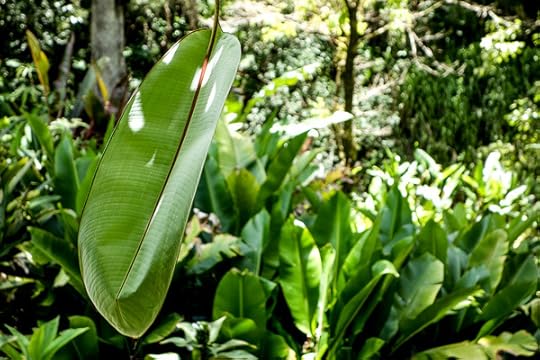
A little later I saw the same guy, walking along talking and laughing with a black Hawaiian woman who was the exact image of a guide named Rayna who’d been with my group on what was one of the very best days of my life, kayaking in the rock islands of Palau near Micronesia, see my old post on this.
“Jake and Rayna start dancing and chanting, crouched, facing each other, their hands shaking in their air, slapping their thighs, vital and joyous as a pair of indestructible cartoon characters. Archetypes.”
So, elated as I was from Waimea falls, and seeing this Rayna look-alike talking with the guy who’d seen the fire in the falls like me, man, it was like seeing a pair of gods some down to Earth, or making themselves visible to me, just for a few minutes, the divine reality a part of my day.

Hylozoic, man. The boulder and the tree.
Rudy Rucker's Blog
- Rudy Rucker's profile
- 583 followers




